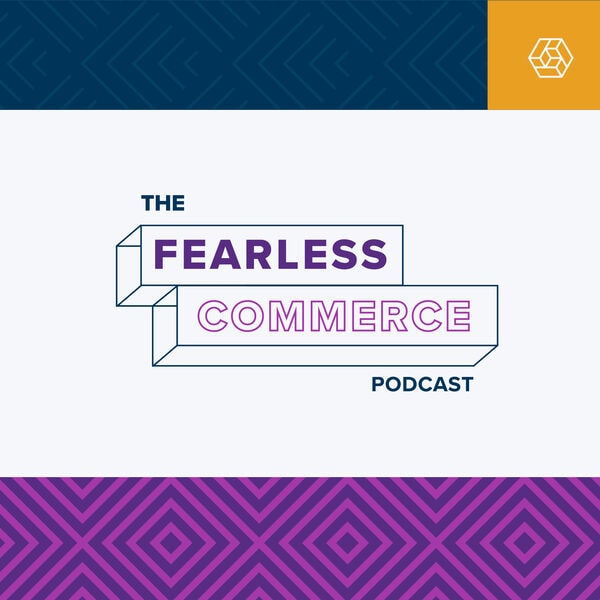In ecommerce, predictions and trends change with the seasons. As the holiday season approaches, many are curious about what’s in store for online merchants. Who better to delve into the data than Signifyd Data Analyst Phelim Killough?
Reviewed, revised and approved by Signifyd humans.
In the second episode of The Fearless Commerce Podcast, co-hosts Mike Cassidy and Adam Silverman sit down with Killough, who is based in Signifyd’s Belfast office. With a sharp focus on consumer insights, fraud trends and the current state of ecommerce, Killough provides a keen perspective on the predictions for this year’s online holiday shopping trends.
This episode offers a glimpse into the future of ecommerce and includes insights into customer loyalty and the influence of inflation on buying patterns. Join us as we explore the numbers, discuss the predictions and look at the factors driving the 2023 ecommerce holiday season. The summary below consists of paraphrased questions and is not a verbatim transcript.
Introduction: predictions for ecommerce performance during the 2023 holiday season
Tell the audience about who you are and your role at Signifyd.
Phelim Killough introduces himself, and explains that he’s responsible for extracting consumer insights from Signifyd’s Commerce Network and observing and tracking fraud trends.
Tell us about the State of Commerce report.
Ecommerce has risen by 5% year to date. A similar trend is projected for Q4, with October expected to rise by 6%, November by 5% due to significant sales and December by 4%. In recent years there has been a trend where consumers have started their holiday shopping earlier in October.
How do you interpret the shift to October becoming a significant month in the holiday season?
Merchants are trying to entice customers earlier by offering attractive rewards and promotions. Their strategy is to secure consumers’ spending before they’re tempted by rival deals, especially during peak sale days when competition intensifies.
Ecommerce growth is keeping pace with inflation
Given the substantial growth during the pandemic, the current 4% to 6% ecommerce growth might seem modest.
While the growth might seem underwhelming year-over-year, especially when compared to previous double-digit growth, there hasn’t been a drop since COVID-19 but there has been slowing. COVID-19 introduced a dramatic shift in ecommerce and the current trends are built on that high foundation. A return to 2019’s levels of U.S. ecommerce share of total retail sales would be a genuine concern. The current growth, while slower, is still on an elevated base established during the pandemic.
Ecommerce merchants should focus on existing customers
What is the role of inflation in buyers’ shopping habits and retailers’ investments this year?
Inflationary concerns are certainly on the radar, with survey results showing consumers are being cautious because of inflation. However, this wariness won’t necessarily deter them from making purchases. Instead, they might opt for more affordable alternatives, wait for sales or employ other economizing strategies.
Buying patterns of customers at different levels of loyalty
Can you share your approach in examining shifts in customer loyalty?
The State of Commerce report is grounded in two main elements: A consumer survey revealing concerns about inflation and data-driven insights into ecommerce sales. The approach to understanding loyalty involves segmenting the consumer-merchant relationship using a two-by-two matrix. This matrix evaluates if a customer has shopped recently (within the last four months) and/or frequently (four or more times within the past 12 months). By segmenting consumers based on these parameters, the study aims to understand the changing nature of loyalty by observing trends over two distinct timeframes.
1% to 2% of customers account for 8% to 12% of all revenue
What were some standout findings or unexpected insights about customer loyalty?
Contrary to the anticipated Pareto principle or the 80/20 rule, 1% to 2% of ecommerce consumers contributed to a staggering 8% to 12% of all online revenue. the entire revenue. While many might love the notion of unwavering customer loyalty – we will refer to these loyal customers as “Soulmates” – in reality that loyalty isn’t an eternal bond to individucal merchants, and can’t be taken for granted.
Retailer challenges: Loyal customers can change from year to year
Do loyal customers stay loyal?
The landscape of customer loyalty is more volatile than one might think. Within the Apparel category, a mere 27% of those branded as ‘Soulmates’ retained their loyalty status in the following year. This indicates that a staggering 70% of the previous year’s “Soulmates” didn’t shop with the same intensity, suggesting a cooling of their ardor for the site.
What should merchants understand about evolving customer loyalty from this data?
While it’s tempting to think that once you’ve wooed a customer, they’re yours for keeps, this is far from the truth. With competition lurking at every digital corner, customer retention demands consistent effort. Ensuring stellar customer experience from the get-go, combined with enticing promotions – not just those aimed at newbies – can help keep these relationships fresh.
How crucial is customer acquisition, considering the dynamics of loyalty?
With the fluidity of customer loyalty as backdrop, acquisition becomes paramount. For businesses eyeing growth in the current ecommerce environment, it’s a dual challenge: strategizing for low-cost acquisition while also bolstering efforts for customer loyalty in a more challenging commercial climate.
Four different categories of loyal ecommerce shoppers
What unique personas for describing customers have you come up with?
In an effort to paint a picture and make customer categories more relatable (and perhaps slightly reminiscent of our own dating histories), several personas were devised:
- Soulmates: Dream customers, both recent and frequent shoppers, akin to that perfect partner you hope sticks around forever.
- Ghosters: Like that friend who suddenly stops returning calls, these customers were once engaged, frequent buyers but have tapered off in the last four months.
- Hot Dates: These are the newbies, the fresh faces on your site. Their history with you doesn’t extend beyond four months, kind of like a fling you’re still trying to figure out.
- Exes: We all have them. These are customers who shopped with you once or twice but haven’t been back in the last four months. They weren’t frequent shoppers when they were around – reminiscent of those short-lived romances we remember as “the one who got away.”
Fun? Yes. But it’s all in service of better understanding the dynamics of customer behavior.
Key verticals in ecommerce
How do these names relate to the feelings merchants might have towards their customers?
Those labels echo the emotional rollercoaster many merchants ride. It’s all fun and games until a loyal customer begins to drift away or “ghost” the merchant. Ghosting, in this context, is seen as more painful than just losing a customer because of the lack of closure. But, chin up! Like in romance, for every lost customer, there’s another potential “Soulmate” just around the corner.
Were there any specific takeaways or patterns you observed from different verticals?
The report highlights Apparel, Electronics, and Home Goods. Apparel and Electronics observed a surge in sales over the last year. However, Home Goods, contrary to expectation, saw a dip. When analyzing customer loyalty, it was evident that Home Goods had a challenging time retaining their “Soulmates” compared to the other two verticals. Notably, those retained weren’t shopping as frequently. Conversely, both Apparel and Electronics, despite the challenges, managed to boost the customer lifetime value of their most loyal patrons.
Are Soulmates buying more?
Is there a way to not just expand the number of Soulmates but to enhance their enthusiasm for spending?
There’s a definite emphasis on growing the “Soulmate” category, ensuring they’re not just loyal but also eager to spend more over time.
What are the trends in loyalty compared to last year’s data?
Comparing the data from 2021-22 to 2022-23, there’s a noticeable upswing. The “Soulmates” bracket saw growth from 1% to 2%, and they now contribute a more significant share, jumping from 8% to 12% of sales . Furthermore, using Electronics as a specific example, over half of the vertical’s sales comes from customers who’ve made purchases at least twice in the past 24 months. This upward trend suggests a general increment in loyalty year over year.
What do you mean when you say “Soulmates” are different for Electronics?
There’s a distinction in categorization, especially for Electronics. While the core concept remains, the specifics defining each category, like “Soulmate” or “Exes,” have been adjusted to better suit the dynamics of the Electronics market.
How customer loyalty is defined is different across verticals
How does the definition of a recent customer differ for Electronics compared to other verticals like Home Goods and Apparel?
Product release schedules for Electronics tend to be more annual, contrasting with Home Goods or Apparel where releases might be more seasonal. Consequently, while for most sectors a “recent customer” might have shopped in the past four months, for Electronics, this definition extends to the past 12 months. Furthermore, a frequent Electronics customer is identified by making purchases over two times within a span of 24 months. This approach ensures a nuanced understanding of customer behaviors specific to each vertical.
Does the nature of products influence the definition or determination of loyalty?
Absolutely. While the intrinsic concept of loyalty remains constant, its specific criteria may shift based on the product type. For instance, the purchase frequency for Electronics is inherently different from Apparel. Thus, when analyzing data, it’s pivotal to consider the unique shopping patterns and product life spans within each vertical.
Why has growth for Home Goods slowed recently, given the pandemic spike?
The surging demand for Home Goods during the pandemic set a new, higher baseline for sales in that category. While growth might have seen a bit of a deceleration recently, it’s crucial to recognize that the current sales figures, even if slightly shrinking, still hover above pre-pandemic levels. In essence, while the explosive growth has normalized a bit, the industry is still in a relatively advantageous position compared to its pre-pandemic state.
Loyalty can flip really easily
What are key takeaways for merchants from the State of Commerce report concerning customer loyalty?
Loyalty is more volatile than many might presume. It’s not a given that once a customer feels loyal, they’ll perpetually stay that way. Nurturing customer relationships demands continuous effort akin to maintaining a marriage. There isn’t a magic switch to ensure loyalty. The golden ring for merchants would be amplifying customer frequency. By introducing reward programs, captivating promotions, and customized outreach, businesses can foster a reciprocal bond, ultimately enhancing the overall customer experience with their brand.
Focus on turning non-loyal shoppers into loyal ones
What strategies would you suggest for merchants looking to cultivate or rejuvenate their loyal customer base?
A clever tactic is to engage with those once-loyal customers who’ve since distanced themselves, namely the ‘Exes’ and ‘Ghosters’, or the newly engaged ‘Hot Dates’. By reaching out through tailored promotions or personalized interactions, there’s a chance to elevate their loyalty status. The ‘win-back’ approach has potential, targeting customers who’ve perhaps deviated due to financial strains or shifts in their lifestyles. From a merchant’s perspective, zeroing in on securing that pivotal second purchase can also pave the path to long-term loyalty.
Might merchants become too complacent, focusing only on gaining new customers and neglecting their loyal base?
There’s indeed a potential trap. With the recent influx of new customers online, especially post-pandemic, the inclination might lean towards building loyalty with this new crowd. Yet, the dynamism of business means tactics may need frequent revising. Despite having a loyal customer base, the emphasis on drawing in and converting new customers remains paramount. Balancing both is the trick.
What does being fearless mean to you?
What does the term “fearless” mean to you?
Being fearless, from a personal standpoint, revolves around preparedness. It’s about having a strategy in place to tackle any unexpected challenges, essentially trying to minimize those elements that instigate fear. Fear often stems from the apprehension of something going awry. Therefore, developing a robust plan and pondering potential mitigating factors is integral to embracing fearlessness. The daunting anticipation, especially when facing significant life changes like becoming a parent, can amplify fears. However, sometimes the best approach is akin to standing on a diving board — it’s more about taking the leap, even if it seems somewhat rash.
Eager for more deep dives into the world of fearless retail innovation? Don’t miss a single episode of the Fearless Commerce Podcast. Please subscribe to our YouTube channel and browse the list of podcasts for all the insights and behind-the-scenes action. If you’re always on the go, catch us at Signifyd on Buzzsprout and tune in to the voices shaping the future of retail. Dive in, stay informed, and be a part of the fearless journey with us.








